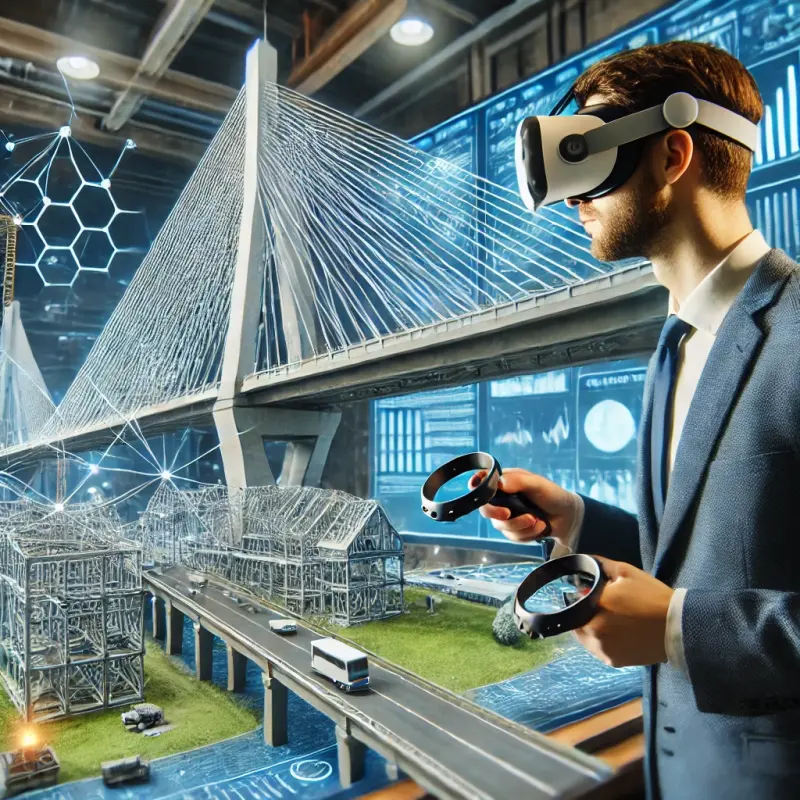Introduction to Virtual Simulations in Bridge Design
Over the last few decades, the integration of advanced technology into engineering practices has led to remarkable improvements in the safety, durability, and efficiency of infrastructure projects. One such advancement that is making waves in the field of civil engineering is Virtual Reality (VR). Traditionally, designing and testing bridge structures involved physical models, extensive calculations, and years of fieldwork to evaluate real-world conditions. However, the advent of VR technology has opened up new dimensions for bridge designers and engineers, offering an immersive, interactive, and highly efficient way to simulate and optimize bridge designs before construction begins.
Virtual simulations, powered by VR technology, are increasingly becoming an essential tool for engineers in the field of bridge design. These virtual environments allow for the creation of digital twins—precise, virtual replicas of bridges—that can be analyzed, tested, and refined without the need for costly physical prototypes. Engineers can interact with the structure in a fully immersive 3D space, visualize stress points, predict how the structure will behave under various conditions, and identify potential flaws long before a single beam is placed in the real world.
In this article, we will explore how VR is transforming bridge design, how engineers are using virtual simulations to enhance safety, and the future potential of this technology in the field of civil engineering.
The Role of Virtual Reality in Engineering
At its core, Virtual Reality (VR) is a technology that creates a simulated environment, allowing users to interact with a 3D space that feels real. VR headsets and other immersive technologies have evolved from gaming tools to powerful applications in a wide range of industries, including architecture, medicine, and, of course, engineering. When it comes to bridge design, VR has the potential to drastically improve the way engineers approach structural integrity, safety analysis, and design optimization.
Traditionally, bridge design involved a labor-intensive process of drafting blueprints, performing calculations, and constructing physical models for testing. While these methods are still important, they often involve limitations in terms of scale, cost, and the inability to replicate real-world conditions. Engineers also rely heavily on theoretical simulations—often two-dimensional—that cannot fully convey the complexity of how a bridge will perform under real-world conditions like heavy traffic, extreme weather, or natural disasters.
Enter VR technology. By using VR simulations, engineers can experience a bridge design from every angle, interact with it in real time, and simulate a wide range of environmental conditions. This allows for a much deeper understanding of how the structure will perform and offers insights that might otherwise be missed in traditional methods.
One of the key advantages of VR in bridge design is its ability to simulate complex, dynamic forces. For example, engineers can model the effects of wind, seismic activity, temperature fluctuations, and even potential collisions. The technology allows them to see how the bridge will respond to these forces and make necessary adjustments to improve structural integrity. This can prevent catastrophic design flaws, such as those that lead to bridge collapses or failure under stress.
Advantages of Virtual Simulations in Bridge Design
The integration of VR simulations into bridge design brings several clear advantages to engineers, project managers, and city planners alike. Some of the most notable benefits include:
1. Enhanced Safety Testing
Virtual reality enables engineers to simulate extreme conditions that might be too dangerous, costly, or impractical to recreate in the real world. For example, VR simulations can replicate a bridge's behavior under heavy traffic loads, seismic events, or harsh weather conditions without putting anyone at risk. This allows engineers to test the safety of their designs in ways that would be impossible with physical models. The ability to virtually "test" a bridge’s resilience and make necessary adjustments before construction starts significantly reduces the risk of structural failures in the future.
2. Cost Reduction
Creating physical prototypes of bridges is an expensive and time-consuming process. With virtual simulations, engineers can experiment with countless design variations without the need for costly materials or labor. Furthermore, the ability to identify and address design flaws early in the process reduces the chances of expensive mistakes during the construction phase. VR technology enables rapid prototyping and iterative design, which can shorten project timelines and lower overall costs.
3. Improved Collaboration
Modern bridge design often involves a large team of engineers, architects, construction experts, and project managers. VR enables these teams to collaborate more effectively by allowing them to interact with the bridge design in a shared virtual space, regardless of their physical location. This can be particularly useful for large projects that require input from various specialists. For example, structural engineers can work with materials experts to ensure the right materials are selected, while environmental engineers can simulate the impact of the bridge on local ecosystems.
4. Design Optimization
With VR, engineers can refine their designs by testing different materials, shapes, and construction techniques in real time. This iterative process leads to more optimized and innovative designs, improving the overall functionality of the bridge. Engineers can identify areas of weakness in the structure and make adjustments before a single piece of material is purchased or installed.
5. Accessibility and Visualization
One of the most significant advantages of VR simulations is the ability to visualize the bridge in a fully immersive 3D environment. This provides engineers, stakeholders, and even the public with a clear understanding of what the finished structure will look like. Stakeholders can "walk through" the bridge, see its scale in relation to the surrounding environment, and get a sense of its aesthetic qualities. This enhanced visualization makes it easier for decision-makers to approve designs and ensure that the project aligns with the community's needs and goals.
